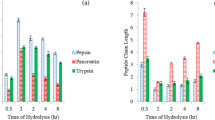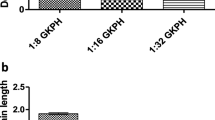Abstract
Composition, functional properties and in vitro antioxidant activities of octopus (Octopus vulgaris) protein hydrolysates (OPHs) were evaluated. OPHs were prepared by treatment with commercial Esperase (OPH-Esp), alkaline protease extract from Zebra blenny (Salaria basilica) (OPH-ZB) and enzyme preparation from Bacillus subtilis A26 (OPH-A26). OPHs showed different degrees of hydrolysis (DH from 17.6 to 21%), and hydrophobic/hydrophilic peptide ratio. The amino acid profiles of OPHs showed a high level of essential amino acids, and Lys was the most abundant amino acid. Enzymatic hydrolysis improved solubility significantly as well as emulsifying and foaming properties of octopus proteins. The emulsifying activity index of OPHs decreased with increasing concentrations. Conversely, the foaming abilities increased as the hydrolysate concentrations increased. For the antioxidant activities, five different in vitro assay systems were investigated. All hydrolysates displayed various degrees and dose dependant antioxidant activities. The highest DPPH scavenging activity and reducing power were achieved by OPH-A26. OPH-Esp displayed the highest ability to prevent the bleaching of β-carotene, whereas OPH-ZB exhibited the highest protection against hydroxyl radical induced DNA breakage. The results suggested that OPHs could be used, as a promising source of functional peptides with antioxidant activities, to formulate functional foods.






Similar content being viewed by others
References
Adler-Nissen J (1986) A review of food hydrolysis specific areas. Int J. Adler-Nissen (ed) Enzymic hydrolysis of food proteins. Elsevier Applied Science Publishers, pp 57–109
Agrebi R, Haddar A, Hajji M et al (2009) Fibrinolytic enzymes from a newly isolated marine bacterium Bacillus subtilis A26: characterization and statistical media optimization. Can J Microbiol 55:1049–1061
AOAC (2000) Official methods of analysis, 17th edn. Association of Official Analytical Chemists, Washington
Aruoma DOI (1998) Free radicals, oxidative stress, and antioxidants in human health and disease. J Am Oil Chem Soc 75:199–212
Ben Khaled H, Ktari N, Ghorbel-Bellaaj O et al (2011) Composition, functional properties and in vitro antioxidant activity of protein hydrolysates prepared from sardinelle (Sardinella aurita) muscle. J Food Sci Technol 51:622–633
Benjakul S, Morrissey MT (1997) Protein hydrolysates from pacific whiting solid wastes. J Agric Food Chem 45:3423–3430
Bersuder P, Hole M, Smith G (1998) Antioxidants from a heated histidine-glucose model system. I: investigation of the antioxidant role of histidine and isolation of antioxidants by high-performance liquid chromatography. J Am Oil Chem Soc 75:181–187
Chalamaiah M, Dinesh kumar B, Hemalatha R, Jyothirmayi T (2012) Fish protein hydrolysates: proximate composition, amino acid composition, antioxidant activities and applications: a review. Food Chem 135:3020–3038
Chalamaiah M, Jyothirmayi T, Diwan PV, Kumar BD (2015) Antioxidant activity and functional properties of enzymatic protein hydrolysates from common carp (Cyprinus carpio) roe (egg). J Food Sci Technol 52:5817–5825
Chen H-M, Muramoto K, Yamauchi F et al (1998) Antioxidative properties of histidine-containing peptides designed from peptide fragments found in the digests of a soybean protein. J Agric Food Chem 46:49–53
Dinis TC, Maderia VM, Almeida LM (1994) Action of phenolic derivatives (acetaminophen, salicylate, and 5-aminosalicylate) as inhibitors of membrane lipid peroxidation and as peroxyl radical scavengers. Arch Biochem Biophys 315:161–169
Elias RJ, Kellerby SS, Decker EA (2008) Antioxidant activity of proteins and peptides. Crit Rev Food Sci Nutr 48:430–441
Gbogouri GA, Linder M, Fanni J, Parmentier M (2004) Influence of hydrolysis degree on the functional properties of salmon byproducts hydrolysates. J Food Sci 69:C615–C622
Gornall AG, Bardawill CJ, David MM (1949) Determination of serum proteins by means of the biuret reaction. J Biol Chem 177:751–766
Jamilah B, Harvinder KG (2002) Properties of gelatins from skins of fish—black tilapia (Oreochromis mossambicus) and red tilapia (Oreochromis nilotica). Food Chem 77:81–84
Kembhavi AA, Kulkarni A, Pant A (1993) Salt-tolerant and thermostable alkaline protease from Bacillus subtilis NCIM no. 64. Appl Biochem Biotechnol 38:83–92
Koleva II, van Beek TA, Linssen JPH et al (2002) Screening of plant extracts for antioxidant activity: a comparative study on three testing methods. Phytochem Anal 13:8–17
Kristinsson HG, Rasco BA (2000) Fish protein hydrolysates: production, biochemical, and functional properties. Crit Rev Food Sci Nutr 40:43–81
Lee J-C, Kim H-R, Kim J, Jang Y-S (2002) Antioxidant property of an ethanol extract of the stem of Opuntia ficus-indica var. Saboten. J Agric Food Chem 50:6490–6496
Lemieux L, Piot J-M, Guillochon D, Amiot J (1991) Study of the efficiency of a mobile phase used in size-exclusion HPLC for the separation of peptides from a casein hydrolysate according to their hydrodynamic volume. Chromatographia 32:499–504
Li X, Luo Y, Shen H, You J (2012) Antioxidant activities and functional properties of grass carp (Ctenopharyngodon idellus) protein hydrolysates. J Sci Food Agric 92:292–298
Lobo V, Patil A, Phatak A, Chandra N (2010) Free radicals, antioxidants and functional foods: impact on human health. Pharmacogn Rev 4:118–126
Morales-Medina R, Tamm F, Guadix AM et al (2016) Functional and antioxidant properties of hydrolysates of sardine (S. pilchardus) and horse mackerel (T. mediterraneus) for the microencapsulation of fish oil by spray-drying. Food Chem 194:1208–1216
Nasri R, Jridi M, Lassoued I et al (2014) The influence of the extent of enzymatic hydrolysis on antioxidative properties and ACE-inhibitory activities of protein hydrolysates from goby (Zosterisessor ophiocephalus) muscle. Appl Biochem Biotechnol 173:1121–1134
Okezie BO, Bello AB (1988) Physicochemical and functional properties of winged bean flour and isolate compared with soy isolate. J Food Sci 53:450–454
Pearce KN, Kinsella JE (1978) Emulsifying properties of proteins: evaluation of a turbidimetric technique. J Agric Food Chem 26:716–723
Qian Z-J, Jung W-K, Kim S-K (2008) Free radical scavenging activity of a novel antioxidative peptide purified from hydrolysate of bullfrog skin, Rana catesbeiana Shaw. Bioresour Technol 99:1690–1698
Saiga A, Tanabe S, Nishimura T (2003) Antioxidant activity of peptides obtained from porcine myofibrillar proteins by protease treatment. J Agric Food Chem 51:3661–3667
Shahidi F, Zhong Y (2010) Lipid oxidation and improving the oxidative stability. Chem Soc Rev 39:4067
Shahidi F, Han X-Q, Synowiecki J (1995) Production and characteristics of protein hydrolysates from capelin (Mallotus villosus). Food Chem 53:285–293
Šližytė R, Daukšas E, Falch E et al (2005) Characteristics of protein fractions generated from hydrolysed cod (Gadus morhua) by-products. Process Biochem 40:2021–2033
Thuy CX, Lam TB, Commick MK (2015) Biochemical and functional properties of fish protein isolate (FPI) from Pangasius hypophthalmus byproducts as influenced by time and degree of hydrolysis (DH). Int Food Res J 22:337–343
Tsumura K, Saito T, Tsuge K et al (2005) Functional properties of soy protein hydrolysates obtained by selective proteolysis. LWT Food Sci Technol 38:255–261
Wilding P, Lillford PJ, Regenstein JM (1984) Functional properties of proteins in foods. J Chem Technol Biotechnol 34:182–189
Yıldırım A, Mavi A, Kara AA (2001) Determination of antioxidant and antimicrobial activities of Rumex crispus L. extracts. J Agric Food Chem 49:4083–4089
Acknowledgement
This work was funded by the Ministry of Higher Education and Scientific Research, Tunisia.
Author information
Authors and Affiliations
Corresponding author
Rights and permissions
About this article
Cite this article
Ben Slama-Ben Salem, R., Bkhairia, I., Abdelhedi, O. et al. Octopus vulgaris protein hydrolysates: characterization, antioxidant and functional properties. J Food Sci Technol 54, 1442–1454 (2017). https://doi.org/10.1007/s13197-017-2567-y
Revised:
Accepted:
Published:
Issue Date:
DOI: https://doi.org/10.1007/s13197-017-2567-y




